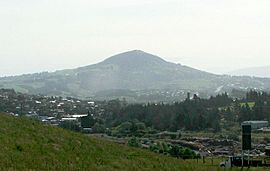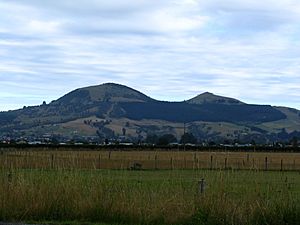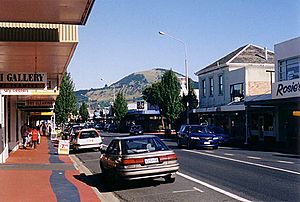Saddle Hill (New Zealand) facts for kids
Quick facts for kids Saddle Hill |
|
|---|---|

|
|
| Highest point | |
| Elevation | 473 m (1,552 ft) |
| Isolation | to Flagstaff) |
| Parent peak | Silver Peak |
| Naming | |
| Native name | Error {{native name}}: an IETF language tag as parameter {{{1}}} is required (help) |
| Geography | |
| Country | New Zealand |
| State/Province | Otago |
| District | Dunedin |
Saddle Hill is a famous landmark in Otago, New Zealand. It's located about 18 kilometers west of Dunedin city. You can find it between the towns of Mosgiel and Green Island. Many people in Dunedin can see this hill from their homes.
From a special lookout spot on its northern side, you can see far across the Taieri Plains. On a clear day, you might even spot Lake Waihola, which is 25 kilometers away!
Contents
What is Saddle Hill?
Saddle Hill has two main peaks, like two bumps on a saddle. The peak on the eastern side is the tallest, reaching 473 meters high. The western peak is called Jaffrays Hill, and it's 431 meters tall.
How Saddle Hill Was Formed
Saddle Hill was created by a volcano that is now extinct. It's part of the ancient Dunedin Volcano complex. The very bottom of the hill is made of a rock called breccia, which formed during the Cretaceous period. On top of this, there are younger volcanic rocks from the Miocene era. Even newer sediments from the Cenozoic period cover these layers.
Over a very long time, erosion has worn away parts of the hill. This has revealed a volcanic plug on the western peak. A volcanic plug is like a stopper of hardened lava that once filled the vent of a volcano. This plug gives the hill its unique, rounded shape.
The Story Behind the Name
Saddle Hill was one of the first places in Otago to be named by European explorers. Captain James Cook named it during his voyage in 1769. He wrote in his journal that it looked like "a remarkable saddle."
Before Europeans arrived, the Māori people had their own stories about the hill. According to their traditions, Saddle Hill is what's left of a giant creature called a taniwha named Meremere. The Māori also had names for the two peaks: the northern peak was called Makamaka, and the southern peak was Pikiwara. Sometimes, old maps from early settlers show the hill as "Saddleback Hill."
Saddle Hill's Past: Mining History
Early European settlers found a small amount of coal on Saddle Hill. They started mining it as early as 1849. This was actually the very first coal mine in all of New Zealand!
Jaffrays Hill, the western peak, was also important for mining. It was heavily mined for basalt gravel until the mid-1980s. Basalt is a hard, dark volcanic rock often used in construction. The Jaffray family owned this land from 1849 until 1937, which is how the hill got its name. People sometimes mistakenly call it Jeffrey's Hill.
In 2008, there were concerns about how the quarrying affected the look of the hill. A landscape expert from the Dunedin City Council (DCC) looked into it. They said the hill looked "relatively unchanged." However, many people disagreed, and there was a lot of public opposition to the mining continuing.



